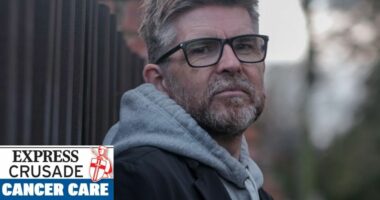Share this @internewscast.com
The recent suicide of a young Pennsylvania police officer has reignited concerns over Lasik eye surgery, as dozens more were pushed to the brink of death over similar complications.
Ryan Kingerski, a 26-year-old officer with the Penn Hills Police Department, took his own life after months of excruciating pain, double vision and persistent headaches.
He claimed the Lasik eye surgery he underwent five months earlier was the source of his suffering.
Now, as more horror stories of agonizing symptoms surface, it’s becoming increasingly clear that Kingerski’s case is not isolated.
‘Everyone has different problems when it comes to Lasik,’ Edward Boshnick, a Miami-based eye doctor, told The New York Post.
‘It’s the biggest scam ever put on the American public… and it’s a multi-billion dollar business.’
Lasik eye surgery, or laser vision correction, is marketed by providers as 95 to 99 percent safe. The so-called ‘simple’ procedure uses an ultraviolet laser to reshape the cornea, improving vision without glasses or contacts.
Morris Waxler, 89, was the former head of the Food and Drug Administration branch responsible for reviewing data and approving the Lasik operation decades ago – a decision he now regrets.

The recent suicide of a young Pennsylvania police officer has reignited concerns over Lasik eye surgery, as dozens more were pushed to the brink of death over similar complications – despite the surgery being marketed by providers as 95 to 99 percent safe

Ryan Kingerski (pictured), a 26-year-old officer with the Penn Hills Police Department, took his own life after months of excruciating pain, double vision and persistent headaches – claiming the Lasik surgery he underwent five months earlier was the source of his suffering

Morris Waxler (pictured), 89, was the former head of the Food and Drug Administration branch responsible for reviewing data and approving the Lasik operation decades ago – a decision he now regrets

In 2018, Detroit TV meteorologist Jessica Starr (pictured) hanged herself at just 35-years-old , leaving behind a 30-page suicide note and videos blaming her tragic decision on the elective surgery
‘It didn’t matter what questions and concerns I had, because the surgeons were very powerful and still are,’ he told The Post.
He had petitioned the FDA to revoke its approval of the Lasik procedure after his own analysis revealed complication rates between 10 to 30 percent – a staggering contrast to the ‘less than one percent’ figure cited by providers.
In 2018, Detroit TV meteorologist Jessica Starr hanged herself at just 35-years-old, leaving behind a 30-page suicide note and videos blaming her tragic decision on the elective surgery.
She documented her struggles in video diary entries. In one recording, she spoke about feeling mad at herself for deciding to go through with the procedure.
According to her family, Starr reached out to various eye doctors and even sought help with a therapist, but her emotional state continued deteriorating.
The young mother ultimately took her own life after struggling with intense pain and vision problems in the two months since her surgery.
‘Prior to the procedure, Jessica was completely normal, very healthy,’ Dan Rose, Starr’s widower, told The Post. ‘There was no depression… no underlying issue.’
Also in 2018, Paul Fitzpatrick, a Canadian father-of-two, killed himself and blamed 20 years of post-Lasik pain in his suicide note.

Waxler petitioned the FDA to revoke its approval of the Lasik procedure after his own analysis revealed complication rates between 10 to 30 percent – a staggering contrast to the ‘less than one percent’ figure cited by providers

Also in 2018, Paul Fitzpatrick, a Canadian father-of-two, killed himself and blamed 20 years of post-Lasik pain in his suicide note

Gloria McConnell (pictured) had two Lasik procedures in 2019, and died by suicide aged 60. Her son said she left a note to her family in which she explained that the pain from the bungled surgery formed part of her decision to end her life

In Kingerski’s heartbreaking suicide note, he wrote: ‘I can’t take this anymore. Lasik took everything from me’ (pictured: Kingerski)
In the years following his operation, Fitzpatrick suffered headaches and described feeling needles in his eyes as well as an unbearable dry and burning sensation.
His family said in the months leading up to his death, the pain was so unbearable he would keep his eyes closed for most of the time, walking with a cane and planned to move in with his parents.
He left a suicide note when he took his life in October of 2018, which described the pain he felt that pushed him to death.
‘I cannot experience any type of pleasure anymore,’ Fitzpatrick wrote.
‘Just the pain of burning eyes inside my head and throughout myself… Since 1996 Pain, pain and more pain, please forgive me for not being strong enough to cope. The past few months have been unbearable.’
Gloria McConnell had two Lasik procedures to fix her short-sightedness in 2019.
Serious complications arose a few weeks after the surgery, including eyes so dry they had a burning sensation, mites and ingrown hairs in her eyelashes.
Four years later, she was barely able to leave her bed.

Starr documented her struggles after Lasik in video diary entries. In one recording, she spoke about feeling mad at herself for deciding to go through with the procedure (pictured)

Fitzpatrick’s family said in the months leading up to his death, the pain was so unbearable he would keep his eyes closed for most of the time, walking with a cane and planned to move in with his parents (pictured)

Paula Cofer (pictured), one Lasik survivor, endured two years of suicidal thoughts following her ‘disastrous’ procedure back in 2000 and runs the Lasik Complications Support Group on Facebook – just one of many organizations on social media created in response to the unspoken dangers of Lasik

Cofer claimed to have known at least 40 people who have taken their own lives after Lasik – unable to go on living with the constant pain and vision problems developed after the procedure
She died by suicide aged 60. Her son said she left a note to her family in which she explained that the pain from the bungled surgery formed part of her decision to end her life.
McConnell even submitted a comment to the FDA’s draft recommendations which said: ‘[LASIK] has destroyed my life.’
In August of 2024, Kingerski took some time off his dream job as a police officer to get Lasik and improve his vision – a decision that seemed safe given the demands of his career.
However, he would tragically never wear his uniform again, as what his parents described as a ‘tragically unsuccessful surgery’ transformed him from a smiling, vibrant person to someone unrecognizable.
The operation left him with debilitating side effects – headaches, dark spots floating in his eye sight, double vision and extreme sensitivity.
In January, still without relief or answers, Kingerski ended his life.
In a heartbreaking suicide note, he wrote: ‘I can’t take this anymore. Lasik took everything from me’.
Paula Cofer, one Lasik survivor, shared that she endured two years of suicidal thoughts following her ‘disastrous’ procedure back in 2000, The Post reported.

Dr. Edward Boshnick (left), a Miami-based eye doctor, said that Lasik is ‘the biggest scam ever put on the American public… and it’s a multi-billion dollar business’

In Lasik and similar surgeries, a small flap is cut into the cornea, which is then raised slightly. This reshaping changes the way that light is refracted to make up for nearsightedness or farsightedness that occur when light doesn’t hit the proper spot on the retina.

Abraham Rutner (pictured getting treated), a 43-year-old Brooklyn electrician, was one of the lucky ones – miraculously finding a sliver of hope after his failed Lasik procedure five years ago when he found Dr. Boshnnick

Dr. Boshnick fitted Rutner (picured) with a scleral lens, a specialized contact that covers and protects corneas damaged by Lasik
‘The Lasik lobby and the surgeons will tell you only one percent of patients have issues afterward,’ the 66-year-old woman told the outlet. ‘That’s not true. There are multiple studies that indicate otherwise.’
‘The percentage of those with poor outcomes are in the double digits, not one percent,’ she added. ‘And they know it.’
In a shocking twist, Cofer claimed to have known at least 40 people who have taken their own lives after Lasik – unable to go on living with the constant pain and vision problems developed after the procedure, The Post reported.
As a way to spread awareness, Cofer runs the Lasik Complications Support Group on Facebook – just one of many organizations on social media created in response to the unspoken dangers of Lasik.
‘I really didn’t want to stick around at times, but I decided I would to get the word out about how dangerous this surgery can be,’ she told the outlet.
‘If you understand Lasik and what it does to the eyes and cornea, you realize you can’t do it on a healthy eye and not expect complications,’ she added.
In Lasik and similar surgeries, a small flap is cut into the cornea, which is then raised slightly.
This reshaping changes the way that light is refracted to make up for nearsightedness or farsightedness that occur when light doesn’t hit the proper spot on the retina.

According to her family, Starr (pictured) reached out to various eye doctors and even sought help with a therapist, but her emotional state continued deteriorating in the two months following the surgery

In Fitzpatrick’s heartbreaking suicide note, he wrote: ‘Just the pain of burning eyes inside my head and throughout myself… Since 1996 Pain, pain and more pain, please forgive me for not being strong enough to cope. The past few months have been unbearable’ (pictured: Fitzpatrick)

According to Dr. Boshnick (pictured), Lasik is nothing more than a ‘BS procedure’

More than 10 million Americans have undergone the procedure since Lasik was FDA approved in 1999, with 700,000 to 800,000 opting for laser vision correction each year
‘Not everyone has severe complications but a lot more people are suffering than you know,’ Cofer said. ‘I got floaters, severe dry eyes, induced astigmatism and severe night vision problems.’
More than 10 million Americans have undergone the procedure since Lasik was FDA approved in 1999, according to the medical journal Clinical Ophthalmology, which reports that 700,000 to 800,000 opt for laser vision correction each year.
Abraham Rutner, a 43-year-old Brooklyn electrician, was one of the lucky ones – miraculously finding a sliver of hope after his failed Lasik procedure five years ago.
‘It’s like you have a layer of oil on top of your eye – it was so hazy and terrible,’ he told The Post. ‘I couldn’t work. I couldn’t drive. I felt like I was still a young man and I lost my life.’
However, he heard about Dr. Boshnick’s work, whose optometric practice offers vision and comfort restoration due to a variety of eye conditions and surgeries – including Lasik.
Rutner was eventually fitted with a scleral lens, a specialized contact that covers and protects corneas damaged by Lasik. Cofer said she was also fitted with the lens – and that it has provided significant relief.
The FDA does warn on its website that the procedure carries risks, including vision loss, glare, halos, double vision and other ‘debilitating visual symptoms’.
According to The American Refractive Surgery Council’s website, ‘Lasik is safe and is one of the most studied elective surgical procedures available today… the rate of sight-threatening complications from Lasik eye surgery is estimated to be well below one percent.’
However, for some experts like Boshnick, Lasik is nothing more than a ‘BS procedure’, according to The Post.
‘People come in with healthy eyes and all they need is eyeglasses,’ Waxler told the outlet.
‘But when surgeons cut the cornea they are removing nerves and leaving the corneas with odd shapes and some patients will have intractable pain.’












